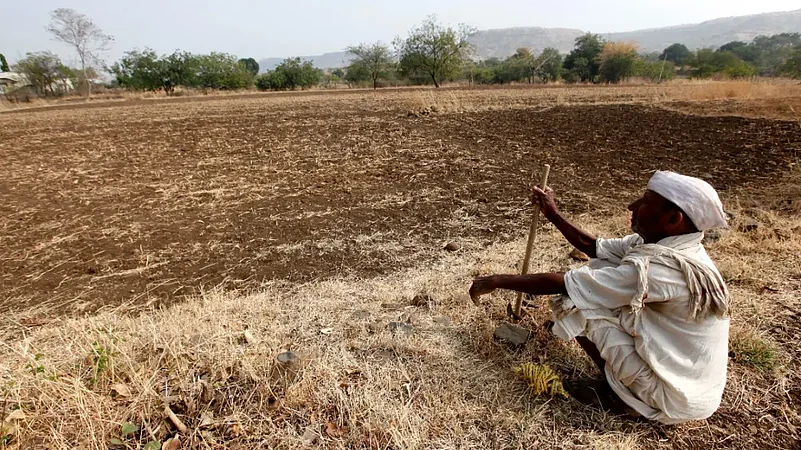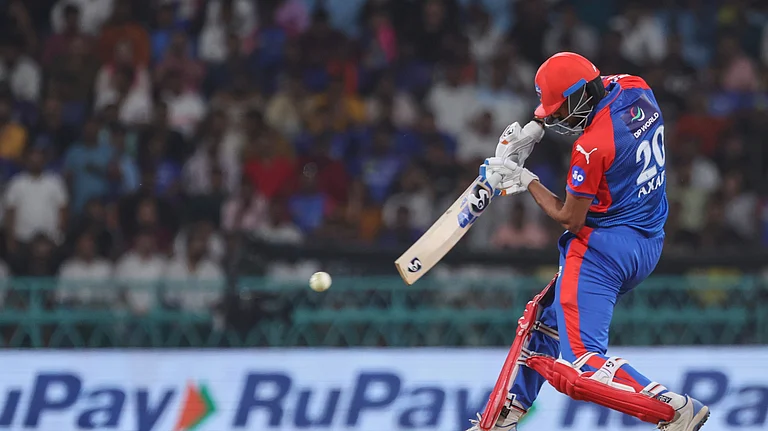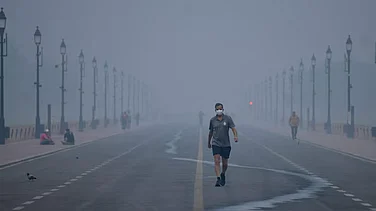Drought has been a constant companion in the life of 50-year-old Janabai Shakare, a resident of Beed taluka in the drought-prone Marathwada region of Maharashtra. Her youth, she said, was spent lamenting on the vagaries of living in a drought-hit area with little access to potable water and accompanying hardships. She married a farmer from a village about 100 kms from her maternal home, only to be living in another village with parched lands.
Overs the years, Janabai’s kitchen has become her laboratory where she experiments with foods that grow in the drought-hit region of Beed, to make tasty preparations for her husband and children.
“I have to make do with whatever is available. I started making various preparations from millets using different wet and dry mixes. They are tasty and keep my children full,” said Janabai, in a telephone conversation with Outlook from Beed.
She said, “Bhakri, thecha, pitla and varan are our main food. I use these in different combinations.”
The food in the drought-prone region of Marathwada is inspired by its climate, landscape and culture, like in the other parts of the state. The landscape of these areas presents a patchwork of food habits. Hardy crops such as jowar (sorghum) and bajra (pearl millet) thrive here.

Traditional foods of Marathwada include varan phal (small roundels of millet flour floating in pressured cooked dal of medium consistency, prepared with turmeric, salt and garnished with cumin seeds), bajrichya mutkya (noodles made from pearl millet flour fried in oil, tempered with green chillies, mustard, turmeric and salt), amti (toor dal with a dash of tadka), methichi gola bhaji (fenugreek greens mixed with gram flour and shaped into small balls, fried and cooked into a onion and tomato based gravy), chilli-garlic thecha (chutney packed with tempered ground red or green chillies and raw garlic with salt), bhakri (a coarse unleavened flat bread made of jowar or bajra cooked on a broad skillet or tawa) and bharleli wangi (brinjal stuffed with a mix of roasted and powdered groundnuts, garam masala, salt, turmeric, finely chopped onions and cooked in a wok).
Drought-prone areas of Marathwada include the districts of Nanded, Beed, Latur, Jalna, Aurangabad and some neighbouring areas. Food is mostly sauteed, stir fried or slow cooked under pressure. Vaafavne or steaming is a technique used frequently before items are fried. Jowar, bajra, toor dal and Bengal gram are the staples. The defining character of cooked food is the sweet and sour flavour where traditionally jaggery is used as the sweetening agent and tamarind is used for the tangy flavour. Dried coconut (khobra) and groundnuts are widely used too.
An interesting preparation which has been known as comfort food is methkut bhaat – methkut is a powder made from lentils, grains and spices and eaten with rice or kichdi (a rice and lentil cooked preparation garnished with onions, garlic, salt and cumin seeds).
The poor man’s food – which did not get much attention in the past – is now very popular in their new avatar as superfoods. These foods promise better health and are increasingly being seen as food that can reduce lifestyle ailments. Recognising the agricultural and health benefits of these “poor man’s foods” as superfoods, the Central government has been promoting the cultivation of nutria-cereals which include sorghum (jowar), pearl millet (bajra), finger millet (ragi) and other small millets, little millet (kutki), kodo millet, barnyard millet (sawa), foxtail millet (kagni) and prosco millet (chena).
The Centre has prepared a road map to promote millets by increasing the acreage of cultivation and output. As per statistics, the Centre has set a target of producing 46 million tonnes by 2022-23. Presently, the production is 17 million tonnes, mentions the data. In 2018, the Union Ministry of Agriculture launched the Nutri-cereals Mission with an allocation of Rs 300 crores.
The present-day popularity of millets is its exhaustive range of health benefits. They are rich in nutrition, fibre content, gluten free and have a low glycemic index – which is ideal to combat diabetes and obesity. While ragi is loaded with calcium, jowar has potassium and phosphorous, kagni has a high content of fibre and kodo millet is rich in iron. These health benefits have made them popular with A-list nutritionists who are popularising them on social media.
These superfoods reduce the uncertainties which currently dominate the agricultural sector, said Sunil Bhembade, a farmer from Beed, who formerly grew sugarcane but has now started cultivating millets as they are hardy crops. Besides, he has been getting a better market and prices for them than he did with sugarcane.
Bembade told Outlook, “They are drought-resistant and are resilient to climate change. They are in high demand and have a better market.”
Though these crops are not new to India, they went off the radar after the Green Revolution in the mid-1960s when rice and wheat started dominating the agricultural sector, said Dada Masure, a millet grower from Jalna.
In this overly sun-kissed area of Marathwada – an excessively hot and arid region, the custom of sun drying vegetables is a traditional yearly ritual. An iconic image of sheets or old saris spread out on the courtyards with pieces of raw mangoes for pickles, tamarind for curries, a variety of spices and dried red chillies drying out in the sun to be later pounded into fine powder by the women of the household. A variety of papads made from wheat, jowar, sabudana (tapioca sago) and bajra too are sun-dried, to be eaten in the later months. Many of the foods that are sun dried are also treated with wet and dry mixes of spices, salt and even yoghurt to enhance their preservation quality, said Janabai.
According to a source from the Agriculture Department of the Maharashtra government, a majority of the farmers in the drought hit belt of the state are unwilling to experiment with different cropping patterns.
The source said, “They continue to do what their previous farming generations have done. Today, the ground water is fast depleting. The farmers should stop growing sugarcane. It is not a crop for the drought belt. Though we have been telling them the same for years now, the farmers are not listening.”
The source further stated that unless the government stopped protecting the sugarcane and cotton crops through the Minimum Statutory Price (MSP), the farmers will continue to grow them, knowing that their losses will be compensated.
The source said, “The last two years have seen good rains in the drought-hit areas of the state which has helped replenish the ground water to a certain level. Many farmers have increased the acreage under sugarcane cultivation. If this continues, we are staring at drought again.”
The diet patterns of people in drought hit areas differ largely due to availability and affordability factors. While potatoes and onions are an integral part of kitchens of those who can afford them, the poor make do without them. For the poor, the distribution of subsidised rice, wheat and lentils for ration card holders under various schemes of the Central and state governments ease their food issues to a large measure.
During the Covid-19 pandemic, the Central Government had announced free rations for the poor which continues to be implemented. The challenge is to add vegetables to the diet.
Brinjal, ghol, patri (both are wild leafy plants that grow in the fields without having to be planted) and tender leaves of the harbara plant (Bengal gram) are the mainstays of the diet. Besan or Bengal gram flour, groundnuts and khobra (dried coconut) are liberally used in the cuisines to thicken gravies.
In many of the kitchens, the use of potatoes is minimal.
Sushilabai More, a home maker from rural Aurangabad, said, “We do not eat potatoes. It cannot be grown in our parched fields. Instead of buying potatoes which are expensive, we settle for some other vegetable. Every Sunday, we cook non-vegetarian food. We have about 12 gaoran (homegrown, colourful breed) hens that lay eggs. We replace the hens that we eat, so we have them throughout the year.”
According to Sushilabai, it is an easier option to eat non-vegetarian food than trying to source vegetables.
Cucumbers, tomatoes, radish (occasionally), bottle gourd, ridge gourd, bitter gourd, pumpkin coriander, spinach, fenugreek leaves are an important part of the vegetarian cuisines in Marathawada. Groundnut oil is liberally used in the food preparations.
“There has to be a layer of phodni (tempering with oil, mustard and cumin seeds) on the top of vegetarian or non-vegetarian foods that are cooked. We eat of a lot of oil,” said Sushilabai.
Those working with farmers in the drought-hit areas of the state opine that with weather patterns becoming more unpredictable and severe due to climate change, farmers with small land holdings find it difficult to plan the cropping pattern.
Mahesh Jagdale, a former sugarcane farmer who shifted to growing soyabean, said, “Farmers continue to plant the water intensive sugarcane in drought-hit areas as politicians are investing large scale public funds for building the required infrastructure for the crop. Look at the number of sugar mills that have been set up by politicians. This is an encouragement to grow sugarcane.”
Jagdale’s shift is governed by the minimum support price fixed by the state government when procuring the produce from the farmers. While the statutory procurement price offered by the state government for sugarcane is Rs 2,200 for a ton, it is Rs 7,500 for a ton of soyabean.
“So farmers have started growing both soyabean and sugarcane,” said Atul Chikshe, a former agriculture officer with the state government. He has worked for 38 years in the drought hit belt of Marathwada studying the farming patterns.
Chikshe told Outlook, “The major foods of the region are jowar (sorghum), wheat (in some quantity), tur and moong dal. For two years there have been good rains in this region, giving the farmers a chance to look at growing other crops.”
He rues the fact that good rains have made the average farmer more ambitious about growing more acreage of sugarcane.
“Sugarcane is not a crop for Marathwada. If the acreage under this crop is increased, there is a fear that the ground water will deplete faster. Farmers just do not listen,” said Chikshe.


























